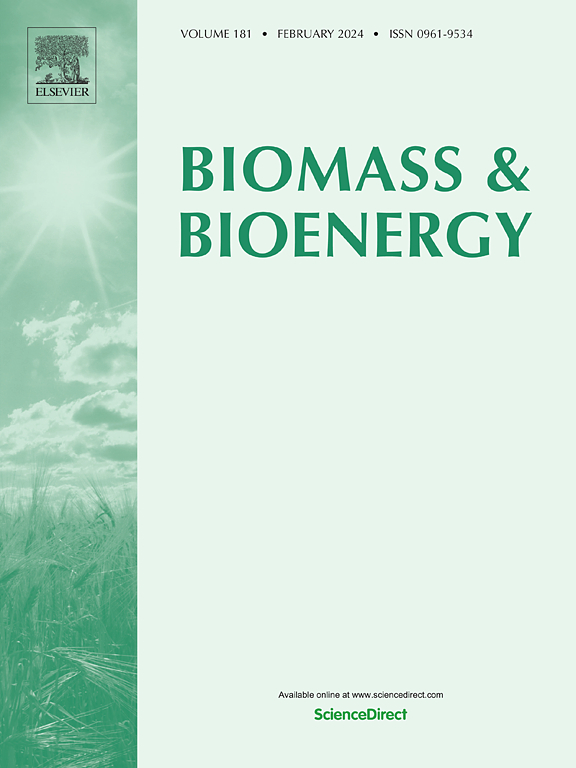Microwave-assisted hydrothermal carbonization of sago (Metroxylon spp) to hydrochar as potential catalyst for etherification of glycerol
IF 5.8
2区 生物学
Q1 AGRICULTURAL ENGINEERING
引用次数: 0
Abstract
The sustainable management of agricultural waste is crucial for achieving global carbon neutrality. Sago (Metroxylon spp) waste is generated in large quantities during starch extraction and is often discarded improperly or burned openly, which leads to significant environmental degradation. In this study, we converted sago waste into valuable hydrochar through microwave-assisted hydrothermal carbonization at temperatures between 200 and 250 °C for 1 h. Proximate and ultimate analyses were performed, as well as analyses of bulk density, pH, thermogravimetric and surface, and structure using scanning electron microscopy and BET. Hydrochar produced at 200 °C had a higher yield (29.8 %) than that produced using conventional heating methods. It also had an enhanced fixed carbon content (22.1–26.4 % compared to 11.04 % in raw biomass) and reduced O/C (0.999–1.432) and H/C (0.007–0.117) ratios. This indicates improved carbonization and hydrophobicity. The BET surface area of the hydrochar increased with temperature, ranging from 57.9 to 179.8 m2/g, with the highest value being reached at 250 °C. SEM analysis revealed that lower temperatures preserved more of the original fibrous structure of the biomass, whereas higher temperatures resulted in greater porosity and surface roughness due to the progressive breakdown and reformation of biomass components. Fourier transform infrared analysis revealed that polar functional groups, such as hydroxyl, carboxyl and carbonyl, decreased at 200 °C, thereby enhancing the stability of the hydrochar. Microwave-assisted hydrothermal carbonization at 200 °C produced hydrochar with balanced properties, achieving 99 % glycerol conversion and 59.9 % glycerol tert-butyl ether selectivity, thereby outperforming commercial resin catalysts.

微波辅助水热碳化西米制烃类作为甘油醚化的潜在催化剂
农业废弃物的可持续管理对于实现全球碳中和至关重要。西米(Metroxylon spp)废料在淀粉提取过程中大量产生,经常被不当丢弃或公开燃烧,导致严重的环境退化。在这项研究中,我们通过微波辅助水热碳化将西米废料转化为有价值的碳氢化合物,温度在200至250°C之间,持续1小时。进行了近似和最终分析,并使用扫描电子显微镜和BET分析了体积密度、pH、热重和表面以及结构。在200°C下生成的碳氢化合物的产率(29.8%)高于使用常规加热方法生成的碳氢化合物。它还提高了固定碳含量(22.1 - 26.4%,而原始生物质为11.04%),降低了O/C(0.999-1.432)和H/C(0.007-0.117)。这表明炭化和疏水性得到了改善。水合物的BET表面积随温度升高而增大,范围为57.9 ~ 179.8 m2/g,在250℃时达到最大值。SEM分析表明,较低的温度更多地保留了生物质的原始纤维结构,而较高的温度由于生物质成分的逐渐分解和重组而导致孔隙度和表面粗糙度增加。傅里叶红外变换分析表明,在200℃时,羟基、羧基和羰基等极性官能团减少,从而提高了烃类的稳定性。在200°C下,微波辅助水热碳化制得性能平衡的烃类,甘油转化率达到99%,甘油叔丁基醚选择性达到59.9%,从而优于商用树脂催化剂。
本文章由计算机程序翻译,如有差异,请以英文原文为准。
求助全文
约1分钟内获得全文
求助全文
来源期刊

Biomass & Bioenergy
工程技术-能源与燃料
CiteScore
11.50
自引率
3.30%
发文量
258
审稿时长
60 days
期刊介绍:
Biomass & Bioenergy is an international journal publishing original research papers and short communications, review articles and case studies on biological resources, chemical and biological processes, and biomass products for new renewable sources of energy and materials.
The scope of the journal extends to the environmental, management and economic aspects of biomass and bioenergy.
Key areas covered by the journal:
• Biomass: sources, energy crop production processes, genetic improvements, composition. Please note that research on these biomass subjects must be linked directly to bioenergy generation.
• Biological Residues: residues/rests from agricultural production, forestry and plantations (palm, sugar etc), processing industries, and municipal sources (MSW). Papers on the use of biomass residues through innovative processes/technological novelty and/or consideration of feedstock/system sustainability (or unsustainability) are welcomed. However waste treatment processes and pollution control or mitigation which are only tangentially related to bioenergy are not in the scope of the journal, as they are more suited to publications in the environmental arena. Papers that describe conventional waste streams (ie well described in existing literature) that do not empirically address ''new'' added value from the process are not suitable for submission to the journal.
• Bioenergy Processes: fermentations, thermochemical conversions, liquid and gaseous fuels, and petrochemical substitutes
• Bioenergy Utilization: direct combustion, gasification, electricity production, chemical processes, and by-product remediation
• Biomass and the Environment: carbon cycle, the net energy efficiency of bioenergy systems, assessment of sustainability, and biodiversity issues.
 求助内容:
求助内容: 应助结果提醒方式:
应助结果提醒方式:


